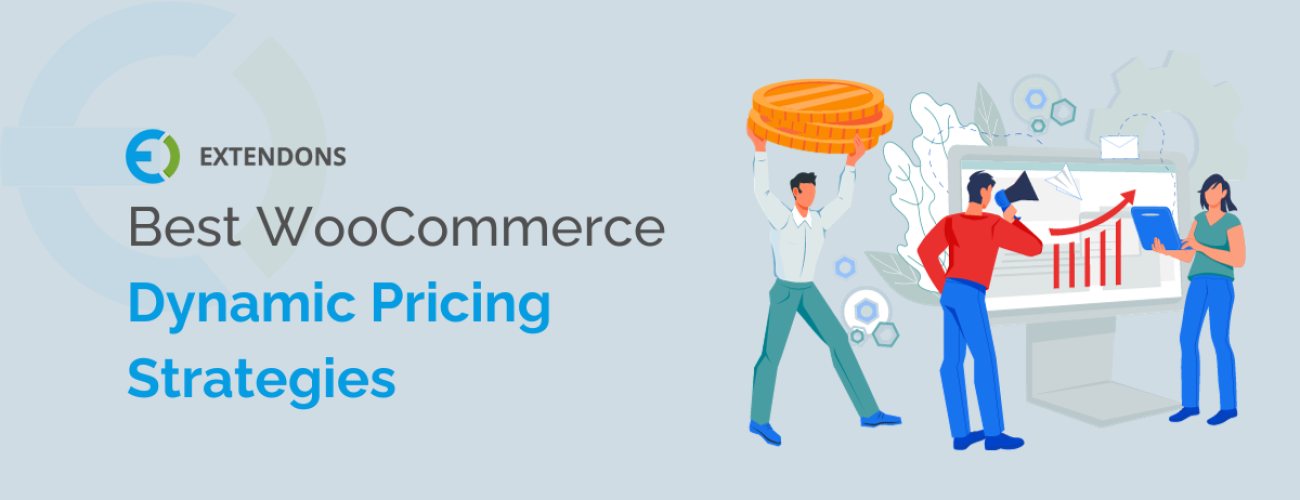- $USD
- English (United States)
- Hire an Expert
- Get Support

Discover the best WooCommerce Dynamic Pricing strategies for 2024 in this comprehensive guide. Dive into various techniques, simple implementation methods, and creative approaches aimed at increasing sales, retaining customers, and boosting your business presence. Whether you’re just getting started or delving into advanced features, this article is here to guide you in mastering dynamic pricing within WooCommerce.
WHAT IS WOOCOMMERCE DYNAMIC PRICING?
WooCommerce dynamic pricing means changing product prices in WooCommerce based on different things. This includes setting prices that can change because of market conditions, how customers act, events that happen at specific times, or rules made by the store owner.
Even though WooCommerce has basic pricing features, more advanced dynamic pricing often needs extra plugins. These plugins help businesses use more complicated pricing plans. For example, they can have different prices based on user groups, special discounts for certain customers, or follow specific rules set by the store owner. This makes dynamic pricing more flexible and optimized.
DYNAMIC PRICING STRATEGIES
BUNDLE DISCOUNTS:
Bundle discounts encourage customers to purchase related products by offering a reduced price for the combined items. This strategy not only increases the average order value but also enhances the overall shopping experience. You can allow customers to choose the products of their choice and create a product bundle with the help of WooCommerce mix and match. It allows you to boost your sales and increase your overall order value.
TIME-BASED DISCOUNTS:
Time-based discounts involve adjusting product prices during specific time frames, such as holidays or weekends. By offering discounts during these periods, businesses create a sense of urgency and capitalize on increased consumer activity. This strategy aims to boost sales by enticing customers with temporary price reductions, fostering a perception of value, and encouraging immediate purchases.
QUANTITY DISCOUNTS:
Quantity discounts is one the popular dynamic pricing strategy which allows you to reward customers who purchase larger quantities of a product. When a customer buys a specified quantity, they receive a discount on the total order. This strategy not only encourages bulk buying but also enhances customer loyalty. Businesses benefit from increased sales volume, while customers feel incentivized to make larger purchases to take advantage of the discounted prices.
MEMBER OR LOYALTY DISCOUNTS:
Member or loyalty discounts involve tailoring pricing for customers who participate in a membership or loyalty program. These exclusive discounts or special offers are designed to reward and retain loyal customers. By providing unique benefits to members, businesses strengthen their customer relationships, increase customer retention, and foster a sense of belonging and value among their most dedicated patrons.
LOCATION-BASED PRICING:
Location-based pricing adapts product prices based on the customer’s geographical location. This strategy considers regional factors, such as economic conditions or shipping costs, to offer competitive and attractive pricing. By tailoring prices to different locations, businesses can optimize their market position, remain competitive in diverse regions, and address specific market demands, thereby appealing to a broader customer base.
ABANDONED CART DISCOUNTS:
Abandoned cart discounts target customers who have added items to their online shopping cart but haven’t completed the purchase. By sending targeted discounts or special offers to these customers, businesses aim to recover potential lost sales. This strategy leverages the customer’s initial interest, providing them with an extra incentive to return to the website and finalize their transaction, thereby reducing cart abandonment rates.
CHALLENGES APPLYING DYNAMIC PRICING IN WOOCOMMERCE
Setting up and managing dynamic pricing in WooCommerce can face challenges. Here are some issues:
COMPLICATED RULE CREATION:
Making detailed pricing rules in WooCommerce can be tough. It gets tricky, especially when dealing with lots of conditions like discounts based on quantity, time-limited offers, or personalized prices for specific users. This needs a good understanding of how WooCommerce works and can cause confusion or mistakes when implementing dynamic pricing.
KEEPING AN EYE ON PRICES:
Always watching market trends and customer actions to adjust prices takes a lot of resources. Businesses using WooCommerce might need efficient systems to keep track of and analyze real-time data. Without smooth processes, businesses might find it hard to adapt quickly and stay competitive, which could affect their ability to get the most out of dynamic pricing.
ACCURATE DATA AND ANALYSIS:
Making sure data is accurate and understanding the right metrics for pricing decisions are vital for dynamic pricing strategies. WooCommerce relies on correct data to make pricing changes. But if the data isn’t consistent, this can slow things down. Ensuring data accuracy and using strong analysis methods are crucial for making dynamic pricing work well in WooCommerce.
CONCLUSION:
To sum it up, getting good at WooCommerce dynamic pricing means using data, thinking about what customers want, and talking clearly. By knowing your customers, trying different things, and making special deals, businesses can do better on WooCommerce.
When you mix making money with keeping customers happy and telling them about prices in a simple way, you build trust. Doing these things with dynamic pricing helps businesses change, stay close to customers, and do well in online selling.
Share Article

 30-day money back guarantee
30-day money back guarantee Dedicated Support Team
Dedicated Support Team Safe & Secure Free Update
Safe & Secure Free Update Safe Customized Solutions
Safe Customized Solutions